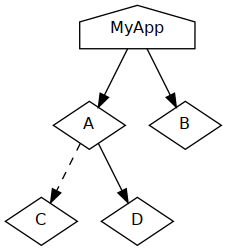Most big C++ projects lack a clear structure: They consist of multiple modules, but it is not as easy to create individually buildable, portable, testable, and reusable libraries from them, as it is with projects written in Rust, Go, Haskell, etc. In this article, I propose a C++ project structure using CMake that makes it easy to have incremental monorepo builds and a nice modular structure at the same time.
Let me show you how to structure a concrete example C++ project in a way that works well for different perspectives while putting no burden on any participating party. First, we have a look at the different perspectives and then how to realize a project structure that facilitates them. In the end, we will build individual modules with nix - it’s possible to do it without nix, but it would also be much more work.
Goal: Maximum Utility for Everyone
There are different perspectives from which a repository can provide value or friction. Most of the time, the people who write the code have their dominating share in deciding how the structure of a project looks like: Developers.
Incremental Builds for Developers
No matter what changed where in the monorepo, there should be one command that just builds and tests “it all” incrementally. From this perspective, it seems like the best way is to have one build system that sets up dependencies and builds everything in a highly parallelized fashion.
Fast CI/CD Pipelines

What’s best for developers performing incremental changes, is not automatically
good for CI/CD:
When changes go into a project by pushing onto a branch and/or opening a merge
request, CI/CD pipelines are triggered.
In monolithic builds, this means that for every changed code line or comment,
the whole repo is rebuilt.
Caching compiler frontends like ccache might be of help
in such situations, but caching at this level brings its own pitfalls and is not
applicable in all situations.
Structuring a project towards modularity and providing a way to build modules individually is a good way to accelerate big pipelines: Small module-internal changes only trigger the builds of the modules and their dependents. In some sense, this way we can facilitate incremental builds on a higher level.
Modular Architecture

Generally, developers should try to not mix different domains in the same code. Mixing domains hinders reusability and makes it harder to inspect for correctness. Having code for different domains separated over different modules also facilitates testing: Each module can have its unit test suite. Often enough, I observed how easy it was to reduce the overall number of test cases and their complexity by decomposing library code. The best proof of the independence of a module is building it in isolation without the surrounding code.
In multiple C++ projects that I have seen, “reusing library code” looked like this:
- A developer would like to reuse an existing library for some new application.
- The library is part of a big monorepo and is not easy to extract. Maybe it could be extracted by duplicating it, but duplication is considered bad in all circumstances.
- Deadlines need to be met, so the compromise is to put the new application into the same monorepo.
- Over the years, the coupling and amount of specialization of the libraries for the resident applications increases the general complexity.
- At some point, a developer will repeat step 1. This time, the slope towards the same procedure is even steeper.
Pointing this out in projects often leads to discussions where the problem is not fully realized by the majority and hence downplayed. In fact, convincing people of architectural improvements is often hard, because this is a strategic consideration with long-term impact and not a tactical one. The book “A Philosophy of Software Design” by John Ousterhout provides some very interesting insights on strategic vs. tactical programmers.
A good way to convince colleagues is generating an architecture graph and showing them that it contains many circular subgraphs. No one is proud of projects with architectural graphs that look like a dish of spaghetti. However, generating architecture graphs is harder, the less modularized the project is - it’s a catch-22 situation.
Monolithic Repo == Monolithic Build System?

So we want to achieve that our C++ project structure is good for developers and pipelines, integrators, (re)users of library code, etc. How do we get there? It should be incrementally buildable for developers when they work at it, but also be modular with all the good things that we mentioned before.
I created a minimal example app that has a somewhat complicated but clean dependency structure. The code is already available on GitHub as a whole: https://github.com/tfc/cmake_cpp_example
Starting the final app produces the following output:
$ ./app/MyApp
abcdFor every letter, it calls one of four library calls:
#include <a.hpp>
#include <b.hpp>
#include <d.hpp>
#include <iostream>
int main() {
std::cout << liba::function_a()
<< libb::function_b()
<< liba::function_c()
<< libd::function_d()
<< '\n';
}
The little architecture diagram on the right shows that libraries A and B
are direct dependencies, while C’s symbols are private to A, but
re-exported by its header.
D can be transitively reached because it is a public dependency of A.
The project structure looks like this, where all libraries and the app are located next to each other at the same level of the repository structure:
.
├── a
│ ├── CMakeLists.txt
│ ├── include
│ │ └── a.hpp
│ └── main.cpp
├── b
│ └── # similar to `a`
├── c
│ └── # similar to `a`
├── d
│ └── # similar to `a`
├── app
│ ├── CMakeLists.txt
│ └── main.cpp
├── CMakeLists.txt
└── README.mdEvery subproject has its CMakeLists.txt that stands for itself as a
standalone project and does not know the location of the others:
CMake allows us to describe libraries in an
object-oriented way where they get symbol names that can be exported to be
imported by others.
Let’s look at the CMakeLists.txt file of library A:
cmake_minimum_required(VERSION 3.13)
# Note that this is a *standalone project* although it's in a subfolder of a
# monorepo
project(A CXX)
# Other modules can reference me as A::A
add_library(A main.cpp)
add_library(A::A ALIAS A) # this alias is explained later
target_include_directories(
A PUBLIC $<BUILD_INTERFACE:${CMAKE_CURRENT_SOURCE_DIR}/include>
$<INSTALL_INTERFACE:include>)
# We need library C and D. But what we don't need is knowing from where.
find_package(C REQUIRED)
find_package(D REQUIRED)
target_link_libraries(
A
PRIVATE C::C
PUBLIC D::D)With this structure, we have a library object that describes what it needs, but
not where it comes from.
CMake is able to discover dependencies via pkg-config or CMake-native files
when they are located in the standard system folders or listed in the
environment variable CMAKE_MODULE_PATH.
If we use this mechanism instead of hardcoding paths, we buy ourselves a lot of
freedom.
I only omitted some lines that would be needed for running make install, but
you can look them up in the GitHub repo.
All libraries and the app have similar simple CMakeLists.txt files which
describe what they need, but not where they come from.
We could now build them one after the other in the right order to get the final
application executable and provide the binaries (App + libraries as shared
object files, or just the app if it is statically linked) as packages.
This would be more of an end-user scenario.
For other developers, we can also publish them as Conan
packages.
The workflow that we want to provide for developers is building everything in
one invocation of cmake and make:
$ mkdir build && cd build
$ cmake ..
$ makeTo enable this with our loosely coupled collection of libraries we can create a
CMakeLists.txt file in the top-level directory of the repository:
cmake_minimum_required(VERSION 3.13)
project(abc_example CXX)
# Define which library symbols are local sub-projects
set(as_subproject A B C D)
# Make find_package a dummy function for these sub-projects.
macro(find_package)
if(NOT "${ARGV0}" IN_LIST as_subproject)
# This is a forward call to the *original* find_package function
_find_package(${ARGV})
endif()
endmacro()
add_subdirectory(a)
add_subdirectory(b)
add_subdirectory(c)
add_subdirectory(d)
add_subdirectory(app)This way, we support the developer’s incremental workflow. But at the same time, developers of other projects can reuse these libraries without having to touch everything else. If a library grows bigger and gets reused by multiple projects, it can easily be moved to its own repository.
The idea to rewrite CMake’s
find_package
function originates from
Daniel Pfeifer’s talk at C++Now 2017.
The talk contains much advice on how to use CMake the correct way and is
generally a must-watch for every C and C++ developer.
The one thing that each library needs to do to prepare for being consumed this way, is to provide an alias like this:
add_library(A::A ALIAS A)Libraries that are imported using find_package get a MyLib::MyLib scope,
but libraries that are imported using add_subdirectory don’t, so we have to
add it like this.
Result
Incremental developer-oriented builds do now work with the typical cmake and
make commands.
At the same time, this does not hinder anyone to create Debian/RPM/whatever
packages for the individual libraries.
In order to show composability and packaging the nix way, I created nix
derivations for each module, which look quite similar to the respective
CMakeLists.txt files but from a higher level:
# project file: a/default.nix
{ stdenv, cmake, libc, libd }:
stdenv.mkDerivation {
name = "liba";
buildInputs = [ libc libd ];
nativeBuildInputs = [ cmake ];
src = ./.;
}The nixified library packages depend just on CMake and respectively on each other as depicted in the architecture diagram earlier. An overlay file puts it all together:
# file: overlay.nix
final: prev: {
liba = final.callPackage ./a { };
libb = final.callPackage ./b { };
libc = final.callPackage ./c { };
libd = final.callPackage ./d { };
myapp = final.callPackage ./app { };
}The callPackage function fills out all the parameters from the derivations’
parameters, which you see in the first line of the example derivation.
the liba derivation finds libc and libd in the global scope of packages,
because the overlay defines them, too.
This way we can import a version of the nixpkgs package list with the overlay:
pkgs = import <nixpkgs> { overlays = [ (import ./overlay.nix) ]; }
# we can now access pkgs.myapp, pkgs.liba, etc. ...The release.nix file
imports a pinned version of nixpkgs and exposes all these build targets.
We can now build them individually:
$ nix-build release.nix -A liba
$ nix-build release.nix -A libb
$ nix-build release.nix -A libc
$ nix-build release.nix -A libd
$ nix-build release.nix -A myapp…which results in individual packages (of which the libraries could be
consumed by other projects, external to our repo).
Of course, building the myapp target attribute transitively builds all the
others that it depends on.
The most interesting thing that we can do at this point might be cross-compilation: I added a few targets to also link the app statically and cross-compile it for AARCH64 and Windows, to demonstrate that the build system does not really need to be prepared for this other than just being as portable as possible (mostly by not holding CMake wrong):
# default build
$ ldd $(nix-build release.nix -A myapp)/bin/MyApp
linux-vdso.so.1 (0x00007fffced69000)
libstdc++.so.6 => .../libstdc++.so.6 (0x00007f03ea419000)
libm.so.6 => .../libm.so.6 (0x00007f03ea339000)
libgcc_s.so.1 => .../libgcc_s.so.1 (0x00007f03ea31f000)
libc.so.6 => .../libc.so.6 (0x00007f03ea116000)
.../ld-linux-x86-64.so.2 => .../ld-linux-x86-64.so.2 (0x00007f03ea631000)
# static build
$ ldd $(nix-build release.nix -A myapp-static)/bin/MyApp
not a dynamic executable
# Aarch64 build
$ file $(nix-build release.nix -A myapp-aarch64)/bin/MyApp
... ELF 64-bit LSB executable, ARM aarch64, version 1 (SYSV), ⏎
dynamically linked, interpreter .../ld-linux-aarch64.so.1, ⏎
for GNU/Linux 3.10.0, not stripped
# Windows build
$ file $(nix-build release.nix -A myapp-win64)/bin/MyApp.exe
... PE32+ executable (console) x86-64 (stripped to external PDB), for MS WindowsSummary
What this project does on a high level is separate dependency management and build management: The CMake files resemble pure recipes which describe who depends on what.
Depending on the use case, the consumer decides how it all comes together by either using the top-level CMake file or the nix dependency management.
Outside users can build the individual modules as packages and install them in their systems globally, produce Conan packages, add them to docker images, or VMs, or consume them via the nix overlay.
If a library grows bigger and gets imported by more outside users, it is much easier now to move it into its own repository (and maybe open-source it).
If you happened to like this article or need some help with Nix/NixOS, also have a look at my corporate Nix & NixOS Trainings and Consulting Services.